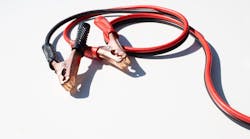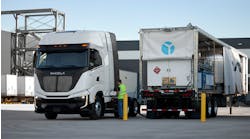Jump starting heavy-duty vehicles presents unique challenges in comparison to light-duty vehicles. Especially during winter, it is prudent to consider the following tips when it comes to successfully jump starting heavy-duty vehicles, and selecting the jump-starting equipment in accordance with the needs of a fleet's operations.
- The starting needs of heavy-duty vehicles are much higher than those of passenger vehicles. So, make sure that you have the right tool for your specific starting needs. How large are the vehicles you are starting? How many starting batteries do they employ (one, two, three, four, eight?) and how large are they? These are important factors to consider as you tool up for this application. Properly matching your equipment to your application will result in more effective starting, more efficient operation, and longer jump starter life.
- Similarly to having the right jump-starting equipment for your specific application, it is important to properly maintain that equipment. Regularly charging your jump starter and keeping it at or near full charge as much as possible will enable you to get the maximum service life possible. This is especially true during periods of extreme cold, when jump starter power is most challenged. Allowing your equipment to reach low state of charge during extreme cold snaps can be very detrimental to its health and longevity.
- Most heavy-duty vehicles contain more than one starting battery, connected in parallel or series (or both), depending on the nature of the starting system. When you have a no-start condition that results in a jump-starting event, it is a good practice to check the condition of all battery connections prior to attempting a start. Are all battery connections well secured? Confirm that there isn’t corrosion present, which can sap power intended for the starter. You want to be sure that your jump starter’s power is getting where it is needed to start the disabled vehicle.
- Another tip for multiple battery starting is to always connect your jump starter to the battery closest to the starter. You want the jump starter’s power to get to the starter, but very low or totally dead batteries along the starting path can sap the jump starter’s power in the same way that poor connections or significant corrosion of the connections can.
- Never underestimate the importance of finding and connecting to a good, proper vehicle ground with the negative clamp. Your jump-starting equipment’s success depends on completing a proper, conductive circuit with the vehicle’s starting system. If you connect the negative clamp to a bad (non) ground or a poor ground, none or very little of the jump starter’s power will reach the starter. You should be looking for a heavy gauge metal part of the vehicle chassis or engine block, away from the battery. (Never connect to a carburetor, fuel lines, or sheet metal body parts.)
- On larger vehicles, such as OTR trucks, first take a few minutes to light the glow plugs. Properly connect the jump starter, put the vehicle’s key in the accessory position, and light the glow plugs, which should take 20-40 seconds. Then, turn the vehicle’s key to the off position and allow the jump starter to recover for 2-3 minutes. Then, attempt to jump start the vehicle. This process will greatly increase your odds of success.
When it comes to deciding what jump starter is right for your operation, there are many factors that should be considered. These include the types and sizes of the vehicles you expect to need to start, the number of jump starts your operation encounters in a given day or week, the number of batteries in the typical vehicle to be started, and the temperature range you experience in your specific climate. Each fleet’s needs are different and, as noted in Tip No. 1 above, it is important to choose the right tool for your needs.
For larger fleets, agricultural operations, large construction contractors, implement yards, and intermodal facilities, it makes sense to move up to larger jump-starting equipment specifically designed for the most demanding jump-starting tasks. After speaking to the Technical Service team at Clore Automotive, many of these operations determine that a large, roll-around jump starter such as the SOLAR HT1224AGM is what is required for their needs. This unit delivers the raw power of 1,400 CCA in 12V mode and 800 CCA in 24V mode. Also, it utilizes non-spillable AGM batteries, so if it is tipped, the internal batteries will not be damaged.
Information provided by: Clore Automotive



